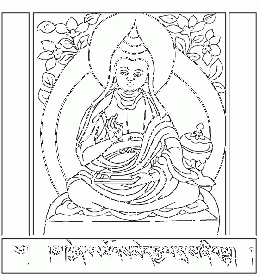Shantideva
Shantideva (Sk: Śāntideva; Zh: 寂天; Tib: ཞི་བ་ལྷ། (Shyiwa Lha, Wylie: zhi ba lha); Mn: Шантидэва гэгээн) was an 8th-century Indian Buddhist scholar at Nalanda University and an adherent of the Madhyamaka philosophy of Nagarjuna.
The Chan Ssu Lun of the Chinese Madhyamika school identifies two different individuals given the name "Shantideva": the founder of the Avaivartika Sangha in the 6th century, and a later Shantideva who studied at Nalanda in the 8th century who appears to be the source of the Tibetan biographies. Archaeological discoveries support this thesis. Two Tibetan sources of the life of Shantideva are the historians Butön and Jetsün Tāranātha. Recent scholarship has brought to light a short Sanskrit life of Shantideva in a 14th century Nepalese manuscript. An accessible account that follows the Butön closely can be found in Kunzang Pelden, The Nectar of Manjushri's speech.
Shantideva was a Brahmin in the southern country of Saurastra (in modern Gujarat), the son of the King Kalyanavarman and he went by the name Shantivarman.
Works
Śikṣāsamuccaya
The Śikṣāsamuccaya (“Training Anthology”) is a prose work in nineteen chapters. It is organized as a commentary on twenty-seven short mnemonic verses known as the Śikṣāsamuccaya Kārikā. It consists primarily of quotations (of varying length) from sūtras, authoritative texts considered to be the word of the Buddha — generally those sūtras associated with Mahāyāna tradition, including the Samadhiraja Sutra.
Bodhicaryavatara
Shantideva is particularly renowned as the author of the Bodhicaryavatara (sometimes also called the Bodhisattvacaryavatara). An English translation of the Sanskrit version of the Bodhicaryavatara is available online, as well as in print in a variety of translations, sometimes glossed as A Guide to the Bodhisattva's Way Of Life or Entering the Path of Enlightenment. It is a long poem describing the process of enlightenment from the first thought to full buddhahood and is still studied by Mahayana and Vajrayana Buddhists today. An introduction to and commentary on the Bodhicaryavatara by the 14th Dalai Lama called "A Flash of Lightning in the Dark of Night" was printed in 1994. A commentary on the Patience chapter was provided by the Dalai Lama in "Healing Anger" 1997, and his commentaries on the Wisdom chapter can be found in "Practicing Wisdom" 2004. Also Geshe Kelsang Gyatso published a translation titled "Guide to the Bodhisattvas Way of Life" in 2002. His line by line commentary to the entire root text is entitled "Meaningful to Behold – The Bodhisattva's Way of Life " 1980. His extensive commentary to the patience chapter is called "How to Solve our Human Problems", 2005. Kunzang Pelden has written a commentary based on that given by Patrul Rinpoche, translated by the Padmakara Translation Group. Patrul Rinpoche was a wandering monk of great scholarship, who dedicated his life to the propagation of the Bodhicharyavatara.
